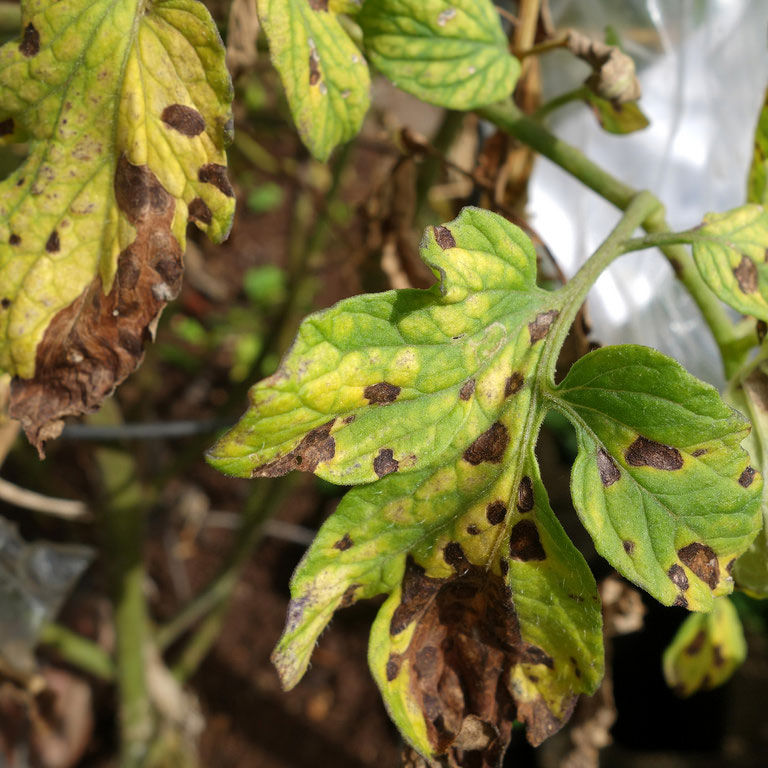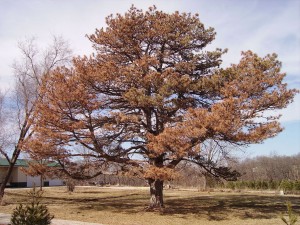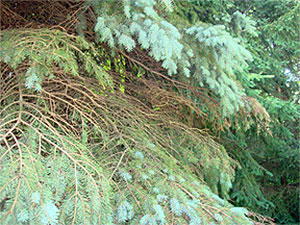“Pining” for drier and healthier growing seasons
Ever find yourself pining away for the “good old days” when things were simpler, a time when gas was cheaper, 911 was just a number, and no one was allergic to peanut butter? Maybe you like the era of Beatles concerts, big collars, and even bigger hair, or you dream of living in the horse-and-buggy days.
Personally, I get misty-eyed when I think back to the early 2000s. It’s not that I can’t remember further back—my memory isn’t quite that bad yet. But those were the good old days when you could grow tomatoes free of blight, and pine needles were green. Have you taken a look at the eastern white pines and Scots pines this summer? I’m pretty sure they’re not supposed to be beige and brown. Plant diseases have really blossomed recently.
Food allergies and terrorism have complex and varied causes, and I don’t pretend to understand their origins. But the mushrooming of plant diseases over the past 15 years or so is not hard to explain. In a word, it now stays too wet for too long during the growing season. (OK, that’s twelve words—so there goes my credibility.) Why is this happening? It has to do with our changed weather patterns.

Septoria leaf spot on a tomoto plant. Photo: Scot Nelson, Creative commons, some rights reserved
Before everyone jumps up to join their respective teams in the Climate-Change Smackdown Series, please note that I have not used any of those bad four-letter words like warming or global or climate (until this sentence, that is). I’m talking about simple weather-station readings taken in northern NY between 1970 and today. This area now gets at least three more inches of precipitation per year than it did back then.
So it rains a little more than it used to—is that the problem? Well, partly. You’ve probably noticed how it seems like we’ve been enrolled in a Weather-of-the-Month Club in recent years. The latter half of April and the entire month of May were practically rain-free. Then the Weather Club sent us a new flavor, and it has barely dried out once during the first two weeks of June.
Since I first noticed this trend in 2005, most summers (2012 was an exception) have included blocks ranging from 20 to 25 consecutive days of measurable rainfall. This did not used to happen. Diseases which once caused occasional mild symptoms in our old weather patterns now kill trees and devastate gardens. Tomato diseases were so bad in 2013 (a virtual monsoon year) that Cornell was investigating if new, more potent strains of weak pathogens like septoria spot had emerged. Conclusion: it was just the weather.

Pine tree stricken with a wilting disease. Photo: Mateinsixtynine, Creative Commons, some rights reserved
To compound the situation, drought stress has weakened trees across the board (so to speak), reducing their ability to resist disease. Plant pathologist Dr. George Hudler of Cornell noted the frequency and severity of drought events has increased markedly beginning in about 1980. According to Hudler, it can take from two to three years for a tree to fully recover from a single five-week dry spell. The problem is trees often do not get a chance to regain their vigor before another such event hits them, leading to a chronic-stress driven downward spiral.
This year, pines throughout New England have “suddenly” turned brown in large numbers. Along roadsides where deicing salt spray drifts onto tree branches, it’s not unusual to see some brown needles come spring. But this year, even forest trees look bad. While some biologists and foresters saw this at low levels a few years ago, it is now widespread.
The Cornell Plant Pathology Lab has had more evergreen-related calls, emails and samples than usual this spring, but so far no single “bad guy” pathogen has emerged as the culprit. Rather it seems that a cadre of normally-weak fungal agents may be involved. The lab has also found a few insect pests on submitted samples, but at levels too low to explain the death of needles. It is frustrating to not have an answer yet, but a lot of people are working to solve the mystery.

Whole brances have lost their needles on this Colorado blue spruce. Photo: Michigan State University Extension
Spruces have also taken a beating in the past ten to twenty years. It is normal for lower branches to die as they become shaded out, but on many spruces, needles are dropping throughout the crown, leaving patches of gray where whole branches have died. While in the past this would happen in cases of overcrowding, or on sites that were too shady, today even trees in the best locations are affected.
It’s good to know that some spruces are more disease resistant than others. Without a doubt, the most vulnerable is the one arborists call Colorado spruce (Picea pungens), known to normal people as blue spruce. Though it is valued for its blue-green color as well as for its deer resistance, it is not the best choice. The ideal location for a blue spruce is on an arid mountain in Colorado. They really aren’t cut out for the Northeast.
Norway spruce appears to be the most disease resistant, and white spruce is somewhere in between. In addition to species selection, planting evergreens farther apart in sunny locations with good air circulation can also help minimize disease. Where possible, water your trees, even mature ones, during dry spells to help keep them healthy.
Seriously, I do miss the good old days. But I’ll try not to pine away excessively. For more information, contact your Cornell Cooperative Extension office.
Paul Hetzler is a horticulture and natural resources educator with Cornell Cooperative Extension of St. Lawrence County.
Tags: evergreens, forestry, plant disease








Don’t know if it is related, but the last few years our wild blueberries leaf out and then the leaves brown, wither. Some of these plants did not even leaf out this season.
I’m not sure if that is related, either, but stress to our ecosystem is ever-increasing, and every species in a given location has its tipping point.